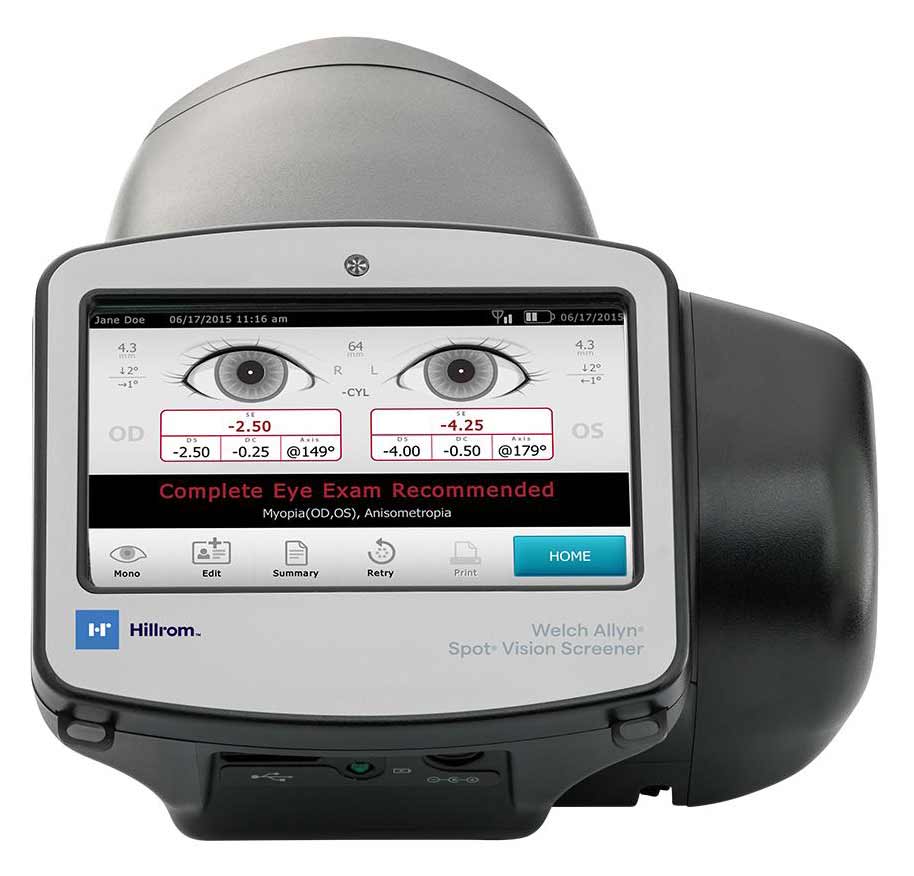 |
|
Amblyopia screening and referral rates increased after a California organization adopted photoscreeners, though rates of diagnosis ebbed and flowed. Photo: Welch Allyn. Click image to enlarge. |
Amblyopia can cause permanent vision loss if not detected and treated before age seven, which is why the US Preventive Services Task Force set a recommendation in 2017 that vision screening occur at least once in all children between ages three and five to detect the condition. A recent study sought to examine whether screenings, referrals and diagnosis of amblyopia have increased since the widespread adoption of photoscreeners in a large healthcare system in California.1 While the data reflected an increase in screening rates since 2017, this did not translate to a reduction in disparities in amblyopia care, suggesting that additional targeted interventions are needed to address these inequalities.
The retrospective cohort study examined billing data from patients who had a well child care visit at approximately three years of age. Data from 2015 to 2017 (n=23,246 patients) was compared to that from 2018 to 2022 (n=34,281 patients) to evaluate amblyopia care trends before and after practices gained standardized access to a photoscreener.
From 2015 to 2022, the screening rate increased appreciably from 5.7% to 72.1%. Similarly, the amblyopia referral rate increased from 17.0% in 2015 to 23.6% in 2018. Following a different trend, the rate of diagnosis started at 2.7% in 2015, peaked at 3.4% in 2018 and then decreased to 1.4% in 2022.
While the data shows that more kids are being screened following the organization’s adoption of photoscreeners, it also reveals persisting racial disparities among the study population. For example, compared with white patients, patients who were Asian, Black, or Hispanic were less likely to be screened, with adjusted odds ratios (AORs) for each race ranging from 0.71 to 0.88. Asian or Hispanic patients were also more likely to be referred than white patients (Asian, AOR: 1.49; Hispanic, AOR: 1.32) and more likely to receive a diagnosis of amblyopia (Asian: AOR: 1.29; Hispanic: AOR, 1.67).
An invited commentary on this study took a magnified look at this finding and proposed the question, “Does access to screening eliminate disparity?”2 According to its author, increasing access to screening may reduce disparity; however, this is only possible if “every step of the care chain does not introduce bias.”
Bias may be introduced throughout the screening and intervention chain in several ways, one of which involves the makeup of photoscreening devices themselves. “Commercially sensitive software algorithms derived from largely Caucasian populations may not apply globally and although referral criteria can often be adjusted, background calculation of refractive error cannot,” the study authors cited from Horwood et al.1 The commentary advises that photoscreener developers should “ensure their systems are built from a diverse cohort of patients to reduce implicit bias in the referral system.”2
The age and experience of the provider may also influence their level of comfort using a photoscreener, the commentary points out. “Clinicians with less tenure were more likely to photoscreen, which may be linked to access and exposure to the technology during training,” its author noted. “Ensuring exposure to photoscreening during training will hopefully maintain high screening rates in the practice patterns of newer physicians.”2
In conclusion, the researchers argue that future endeavors are needed to address the observed screening gap. “Disparately untreated and undertreated children with amblyopia are at risk of reaching visual maturity with disease burdens that will accentuate the disproportionate impact of avoidable visual impairment. Given that rates of visual impairment in the US have been predicted to significantly increase by 2050, our study highlights that more needs to be done beyond mass photoscreening to decrease existing disparities,” they urged.1
1. Stults CD, Liang SY, Wilcox J, Nyong’o OL. Amblyopia care trends following widespread photoscreener adoption. JAMA Ophthalmol. February 1, 2024. [Epub ahead of print]. |


